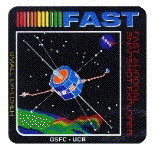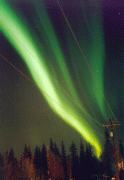

The FAST spacecraft carries 4 instrument packages:
- Time-of-Flight Energy Angle Spectrograph (TEAMS): UNH, Lockheed-Martin Palo Alto, MPE, UC Berkeley
- Electrostatic Analyzers (ESA): UC Berkeley
- Electric Field Experiment (EFE): UC Berkeley
- Magnetic Field Experiment (MFE): UCLA
The spacecraft was built at the Goddard Space Flight Center. FAST is the second of NASA's Small Explorer (SMEX) missions. With its unique orbit through the auroral region (elliptical 400 x 4000 km and almost polar) and its capability to observe with very high resolution, it will ideally complement the Global Geospace (GGS) project in which different regions of the magnetosphere are scanned simultaneously. In particular, FAST will play together with POLAR, which will deliver the big picture, while orbiting overhead and providing a top view of the polar region.
FAST was launched not from a solid rocket like many missions, but was instead lifted closer to orbit by an aircraft, after which the satellite was deployed. You can see some pictures of how the "second stage" was attached to the aircraft here.
Here is a cartoon summary of TEAMS` principles of operation, and here is a schematic version.
To learn more, read the instrument description paper, or watch the Time of Flight Detector Movie
High Resolution Study of Auroras on the Fly
 Auroras are seen as thin walls of light over the polar regions of the Earth. The beauty and variety of their display have inspired and intrigued mankind for thousands of years as to what their lights are made of. Early explanations featured phenomena, such as flames in the sky, reflections of sunlight, or battles between divine armies. Only in this century have we learned that aurora are intimately connected with the Earth's magnetic field and its interaction with the solar wind, a continuous but variable supersonic flow of particles from the Sun.
Auroras are seen as thin walls of light over the polar regions of the Earth. The beauty and variety of their display have inspired and intrigued mankind for thousands of years as to what their lights are made of. Early explanations featured phenomena, such as flames in the sky, reflections of sunlight, or battles between divine armies. Only in this century have we learned that aurora are intimately connected with the Earth's magnetic field and its interaction with the solar wind, a continuous but variable supersonic flow of particles from the Sun.
This interplay works like a giant electric generator which produces high electric fields and strong currents. In the course of these events, ions and electrons are accelerated to high energies. Energetic electrons, guided by the magnetic field, bombard the upper layers of the Earth's atmosphere. Similar to what happens on a TV screen these electrons produce a colored display in the night sky, when they excite molecules in the air.
(Schematic view of aurora and satellite orbit, 12.5 k Gif)
The sheet-like structure of the auroras which is guided by the Earth's magnetic field is very thin (10 - 100 km), and thus a satellite passes different regions within seconds. Therefore, data have to be taken with extremely high time resolution to resolve the interesting spatial structures.
Goddard Space Flight Center's FAST Page
Recently, two high school students from the UNH SMART program explored the research involved with FAST and wrote a web page to summarize their involvement. Please check out their page.